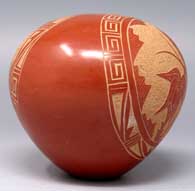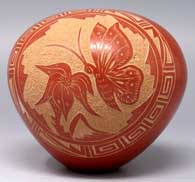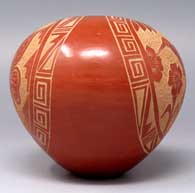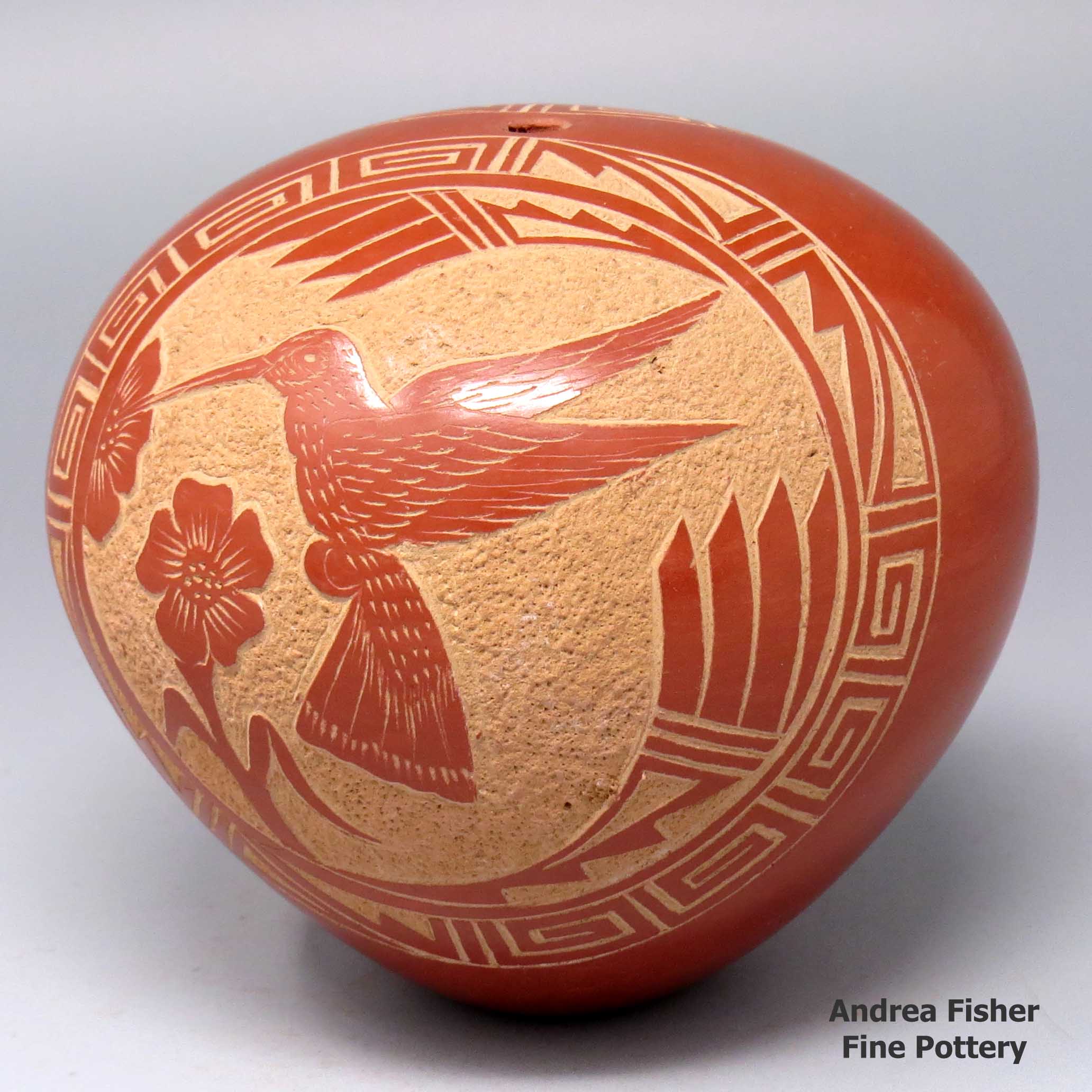
Jemez
$ 425
jtje1j233
Red seed pot with a sgraffito hummingbird-and-flower medallion and a butterfly-and-flower medallion and more geometric design
3.5 in H by 3.75 in Dia
Condition: Very good
Signature: V. Tafoya Jemez with her feather hallmark
Tell me more! Buy this piece!
(505) 986-1234 - www.andreafisherpottery.com - All Rights Reserved
Vangie Tafoya
Jemez
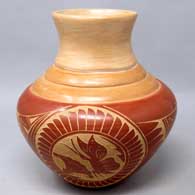
Vangie Tafoya was born into Jemez Pueblo (Walatowa) in August, 1944. She is half Jemez, half San Ildefonso. The San Ildefonso side is related to Maria Martinez but Vangie learned to make pottery the Jemez way, from her grandmother Maria Sanchez Colaque.
Vangie credits her grandmother with inspiring her to continue the family tradition of making pottery but she has developed her own style of freehand sgraffito designs with exquisite avanyus, flowers, hummingbirds and feathers. She seems to decorate mostly using sgraffito but she makes seed pots, jars, wedding vases, melon bowls, pitchers, canteens and miniatures. Most of her pieces are highly polished redware.
Vangie has participated in shows like the Santa Fe Indian Market, Eight Northern Pueblos Arts and Crafts Show, the Gallup Inter-Tribal Ceremonials and the Heard Museum Guild Indian Fair and Market. She earned a Best in Show ribbon at the New Mexico State Fair in 1993 and other ribbons kept coming. She signs her pieces: Vangie Tafoya, Jemez, followed by an eagle feather for her clan origin.
Jemez Pueblo

Ruins of San Jose de las Jemez Mission
As the drought in the Four Corners region deepened in the late 1200's, several clans of Towa-speaking people migrated southeastward to the Canyon de San Diego area in the southern Jemez mountains. Other clans of Towa-speaking people migrated southwest and settled in the Jeddito Wash area in northeastern Arizona, below Antelope Mesa and southeast of Hopi First Mesa. The migrations began around 1275 and were mostly complete by 1350.
Archaeologist Jesse Walter Fewkes argues that pot shards found in the vicinity of the ruin at Sikyátki (near the foot of Hopi First Mesa) speak to the strong influence of earlier Towa-speaking potters on what became "Sikyátki Polychrome" pottery (Sikyátki was a village at the foot of First Mesa, destroyed before the first Hopi contact with the Spanish in 1540). Fewkes maintained that Sikyátki Polychrome pottery is the finest ceramic ware ever made in prehistoric North America.
Francisco de Coronado and his men arrived in the Jemez Mountains of Nuevo Mexico in 1539. By then the Jemez people had built several large masonry villages among the canyons and on some high ridges in the area. Their population was estimated at about 30,000 and they were among the largest and most powerful tribes in Northern New Mexico. Some of their pueblos reached five stories high and contained as many as 3,000 rooms.
Because of the nature of the landscape they inhabited, farming was very hard. So the Jemez became traders, too, and their people traded goods all over the Southwest and northern Mexico.
The arrival of the Spanish was disastrous for the Jemez and they resisted the Spanish with all their might. That led to many atrocities against the tribe until they rose up in the Pueblo Revolt of 1680 and evicted the Spanish from northern New Mexico. With the Spanish gone, the Jemez destroyed much of what they had built on Jemez land. Then they concentrated on preparing themselves for the eventual return of the hated priests and the Spanish military.
The Spanish returned in 1692 and their efforts to retake northern New Mexico bogged down as the Jemez fought them doggedly for four years. In 1696 many Jemez came together, killed a Franciscan missionary and then fled to join their distant relatives in the Jeddito Wash area. They remained at Jeddito Wash for several years before returning to the Jemez Mountains. As a result of that long ago contact, there are still strong ties between the Jemez and their cousins on Navajo territory at Jeddito. On their return to the Jemez Mountains, the people built the pueblo they now live in (Walatowa: The Place) and made peace with the Spanish government.
Some of the Jemez people had been making a type of plainware pottery (simple, undecorated, utilitarian) when they were still in the Four Corners area, while others had developed a distinctive type of black-on-white pottery. In moving to the Jemez Mountains, they brought their knowledge and techniques with them but had to adapt to the different materials available to work with. Over time, the Jemez got better in their agricultural practices and began trading agricultural goods to the people of Zia Pueblo in return for pottery. By the mid-1700's, the Jemez were producing almost no pottery.
East of what is now Santa Fe is where the ruins of Pecos Pueblo are found. Pecos Pueblo was a large pueblo housing up to 2,000 people at its height. The people of Pecos and the Galisteo Basin were the only other speakers of the Towa language in New Mexico and when that area fell on increasingly hard times (Apache and Comanche raids, European diseases, drought), Pecos was finally abandoned in 1838 when the last 17 residents moved to Jemez. The Governor of Jemez welcomed them and allowed them to retain many of their Pecos tribal offices (governorship and all). Members of former Pecos families still return to the site of Pecos Pueblo every year to perform religious ceremonies in honor of their ancestors.
When general American interest in Puebloan pottery started to take off in the 1960's, the people of Jemez sought to recover that lost heritage. Today, the practice of traditional pottery-making is very much alive and well among the Jemez.
The focus of Jemez pottery today has turned to the making of storytellers, an art form that now accounts for more than half of their pottery production. Storytellers are usually grandparent figures with the figures of children attached to their bodies. The grandparents are pictured orally passing tribal songs and histories to their descendants. While this visual representation was first created at Cochiti Pueblo (a site in close geographical proximity to Jemez Pueblo) in the early 1960's by Helen Cordero, it speaks to the relationship between grandparents and grandchildren of every culture.
The pottery vessels made at Jemez Pueblo today are no longer black-on-white. Instead, the potters have adopted many colors, styles and techniques from other pueblos to the point where Jemez potters no longer have one distinct style of their own beyond that which stems naturally from the materials they themselves acquire from their surroundings: it doesn't matter what the shape or design is, the clay says uniquely "Jemez."
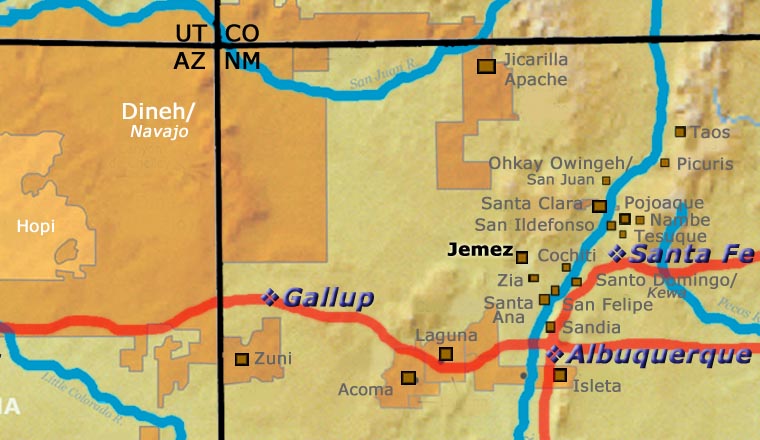
Jemez Pueblo at Wikipedia
Jemez Pueblo official website
Jemez Pueblo at the Catholic Encyclopedia
Pueblos of the Rio Grande, Daniel Gibson, ISBN-13:978-1-887896-26-0, Rio Nuevo Publishers, 2001
Prehistoric Hopi Pottery Designs, Jesse Walter Fewkes, ISBN-0-486-22959-9, Dover Publications, Inc., 1973
Seed Pots
Acoma, Hopi, Isleta, Jemez, Laguna, San Felipe, San Ildefonso, San Juan, Santa Clara
Acoma Pueblo
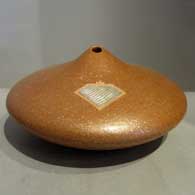
Hopi
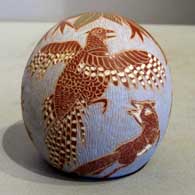
Santa Clara Pueblo
It was a matter of survival to the ancient Native American people that seeds be stored properly until the next planting season. Small, hollow pots were made to ensure that the precious seeds would be kept safe from moisture, light and rodents. After seeds were put into the pot, the small hole in the pot was plugged. The following spring the plug was removed and the seeds were shaken from the pot directly onto the planting area.
Today, seed pots are no longer necessary due to readily available seeds from commercial suppliers. However, seed pots continue to be made as beautiful, decorative works of art. The sizes and shapes of seed pots have evolved and vary greatly, depending on the vision of Clay Mother as seen through the artist. The decorations vary, too, from simple white seed pots with raised relief to multi-colored painted, raised relief and sgraffito designs, sometimes with inlaid gemstones and silver lids.
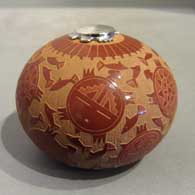
Santa Clara Pueblo
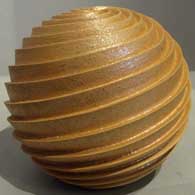
Jemez Pueblo
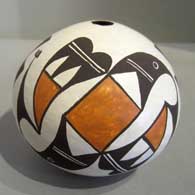
Acoma Pueblo
Copyright © 1998-2024 by


